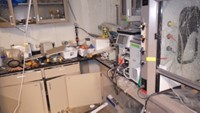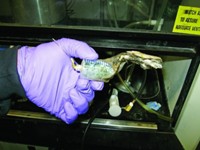Advertisement
Grab your lab coat. Let's get started
Welcome!
Welcome!
Create an account below to get 6 C&EN articles per month, receive newsletters and more - all free.
It seems this is your first time logging in online. Please enter the following information to continue.
As an ACS member you automatically get access to this site. All we need is few more details to create your reading experience.
Not you? Sign in with a different account.
Not you? Sign in with a different account.
ERROR 1
ERROR 1
ERROR 2
ERROR 2
ERROR 2
ERROR 2
ERROR 2
Password and Confirm password must match.
If you have an ACS member number, please enter it here so we can link this account to your membership. (optional)
ERROR 2
ACS values your privacy. By submitting your information, you are gaining access to C&EN and subscribing to our weekly newsletter. We use the information you provide to make your reading experience better, and we will never sell your data to third party members.
Safety
Ensuring Safe Laboratories
October 12, 2015
| A version of this story appeared in
Volume 93, Issue 40
Aug. 31, page 20: The Government & Policy Concentrate about business R&D spending incorrectly stated the amount of R&D spending by the chemical manufacturing sector. All numbers referring to chemical manufacturing R&D are billions of dollars.
Oct. 5, page 5: The News of the Week story on the discovery of water on Mars incorrectly described the effect of the dissolved salts on the water’s evaporation. The dissolved ions would slow the rate of evaporation of martian water.
Reading about the lab explosion at the University of California, Berkeley (C&EN, Aug. 24, page 36), took me back to my third year as an undergraduate, during the summer of 2002. I synthesized about 1 g of tetramethylammonium permanganate and was using a metal spatula to transfer the compound from a small glass filter frit when the compound exploded. I, like the student in the UC Berkeley incident, “became a little complacent” but was lucky to avoid lasting injury.
Incidents such as this highlight the need for earnest laboratory safety training early and throughout undergraduate chemistry programs. As undergraduates transition into graduate studies, and later on to professorships and industry positions, they can carry with them (and pass on) their training. Perhaps a self-perpetuating approach to laboratory safety training such as this can stave off complacency.
Michael R. Marvel
Batavia, Ill.
Academia continues to follow more of the same, which evidence shows to be inadequate. Turning young researchers back to reviewing material safety data sheet (MSDS) documents and reviewing standard operating procedures is not the answer to hazardous operations safety. It is, however, a first step. It is imperative to know that one is working with a hazardous material. What is missing is how to proceed.
Government and industry have learned that established good practices in and of themselves do not ensure safety. The answer lies with the application of safety analysis to selected hazardous operations. Safety analysis identifies potential accident pathways; provides estimates of likelihood, consequence, and risk for each; and identifies controls for those scenarios that require risk or consequence reduction.
For this type of operation, a formal written procedure, which is followed diligently, would be required. The safety analysis would analyze each step of the procedure with attention directed to human errors, equipment failures, and other concerns. In many cases, the procedure is analyzed while working simultaneously with an inert simulation.
Why aren’t good practices good enough? Part of the answer is that even the most diligent researcher has a human error probability of roughly 0.001. Additionally, even the best apparatus may have incipient weaknesses. Another possibility is that the procedure or apparatus might not be quite as robust as originally perceived.
Operations and equipment for hazardous operations in government and industry are routinely modified and tweaked when developed side by side with safety analysis. For the UC Berkeley example, two possible initiating events are selecting the wrong spatula by mistake and having a sample fall off a plastic spatula onto a metal ring stand base. More information on the experiment, procedure, and laboratory environment would surely result in more scenarios to evaluate and control if necessary.
There are other issues as well, such as the extent to which the material has been characterized regarding sensitivity to abrasion, impact, static, heat, light, etc. What quantities are appropriate for direct-contact laboratory operations? When is a blast shield required?
The intent of safety analysis is not to impede research or creativity, but rather to identify when hazards require additional evaluation and control to ensure that work proceeds as intended. One collateral benefit of safety analysis is that it also identifies operational and product quality issues that are useful to recognize before one assembles the equipment or begins the work.
Stephen L. Nicolosi
Tucson




Join the conversation
Contact the reporter
Submit a Letter to the Editor for publication
Engage with us on Twitter